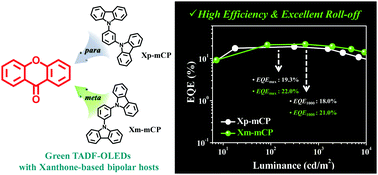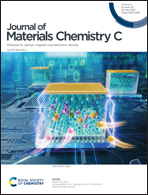Achievement of high efficiency with extremely low efficiency roll-off in solution-processed thermally activated delayed fluorescence OLEDs manufactured using xanthone-based bipolar host materials†
Abstract
The use of soluble host materials and thermally activated delayed fluorescence (TADF) emitters is indispensable for developing high-efficiency organic light-emitting diodes (OLEDs) by cost-effective solution processes. In this study, two bipolar hosts were designed as structural isomers, namely 3-(3,5-di(9H-carbazol-9-yl)phenyl)-9H-xanthen-9-one (Xp-mCP) and 2-(3,5-di(9H-carbazol-9-yl)phenyl)-9H-xanthen-9-one (Xm-mCP). The two host materials were synthesized by combining the unipolar host, 1,3-di(9H-carbazol-9-yl)benzene (mCP) with 9H-xanthen-9-one as an electron-accepting moiety. The two hosts exhibit good solubility in various organic solvents and high triplet energy (ET = 2.67 eV for Xp-mCP and ET = 2.82 eV for Xm-mCP), which renders them suitable for t4CzIPN-containing solution-processable green TADF-OLEDs. The maximum external quantum efficiency (EQE) values were 19.3% and 22.0% for Xp-mCP- and Xm-mCP-based green TADF-OLED, respectively. Among them, the device comprising Xm-mCP showed an excellent efficiency roll-off behavior by displaying only a 4.5% decrease and 11.4% decrease at 1000 cd m−2 and 2000 cd m−2, respectively. These results show the significant potential of xanthone-mCP host materials to develop solution-processable OLED technologies.



 Please wait while we load your content...
Please wait while we load your content...